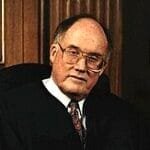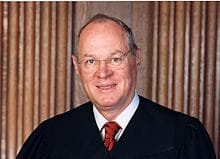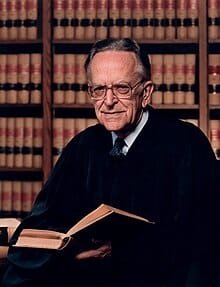 Chief Justice William H. Rehnquist served on the U.S. Supreme Court for 33 years, including 19 years as Chief Justice, making him one of the longest-serving justices in American history. Appointed as an Associate Justice by President Richard Nixon in 1972 and later elevated to Chief Justice by President Ronald Reagan in 1986, Rehnquist played a pivotal role in shaping the Court’s jurisprudence during a transformative period.
Chief Justice William H. Rehnquist served on the U.S. Supreme Court for 33 years, including 19 years as Chief Justice, making him one of the longest-serving justices in American history. Appointed as an Associate Justice by President Richard Nixon in 1972 and later elevated to Chief Justice by President Ronald Reagan in 1986, Rehnquist played a pivotal role in shaping the Court’s jurisprudence during a transformative period.
Rehnquist was known for his conservative judicial philosophy, advocating for federalism, judicial restraint, and a limited role for the judiciary in expanding individual rights. His tenure as Chief Justice was marked by efforts to shift power back to the states, challenging the dominance of federal authority in areas traditionally governed by state law. This approach was evident in landmark cases such as United States v. Lopez (1995), where the Court struck down a federal law banning guns in school zones, emphasizing the limits of Congress’s power under the Commerce Clause.
Another significant ruling during Rehnquist’s leadership was Bush v. Gore (2000), in which the Court effectively decided the outcome of the 2000 presidential election by halting the Florida recount. Although the decision was deeply controversial, it underscored Rehnquist’s influence on the Court and his ability to guide its conservative majority.
Rehnquist also left a lasting impact on constitutional law regarding religious freedom. In Van Orden v. Perry (2005), he upheld the display of a Ten Commandments monument on public grounds, arguing that such displays did not violate the Establishment Clause of the First Amendment.
Despite his conservative leanings, Rehnquist’s tenure as Chief Justice was characterized by his efforts to maintain collegiality among the justices and ensure the Court operated efficiently. He streamlined the Court’s docket and encouraged consensus in decision-making, fostering a sense of unity even amid ideological differences.
Rehnquist’s legacy is multifaceted, reflecting his profound influence on federalism, the separation of powers, and the balance between individual rights and governmental authority. His contributions continue to shape debates over the role of the judiciary in American democracy.
Let me know if you’d like more details on additional rulings or other justices!











